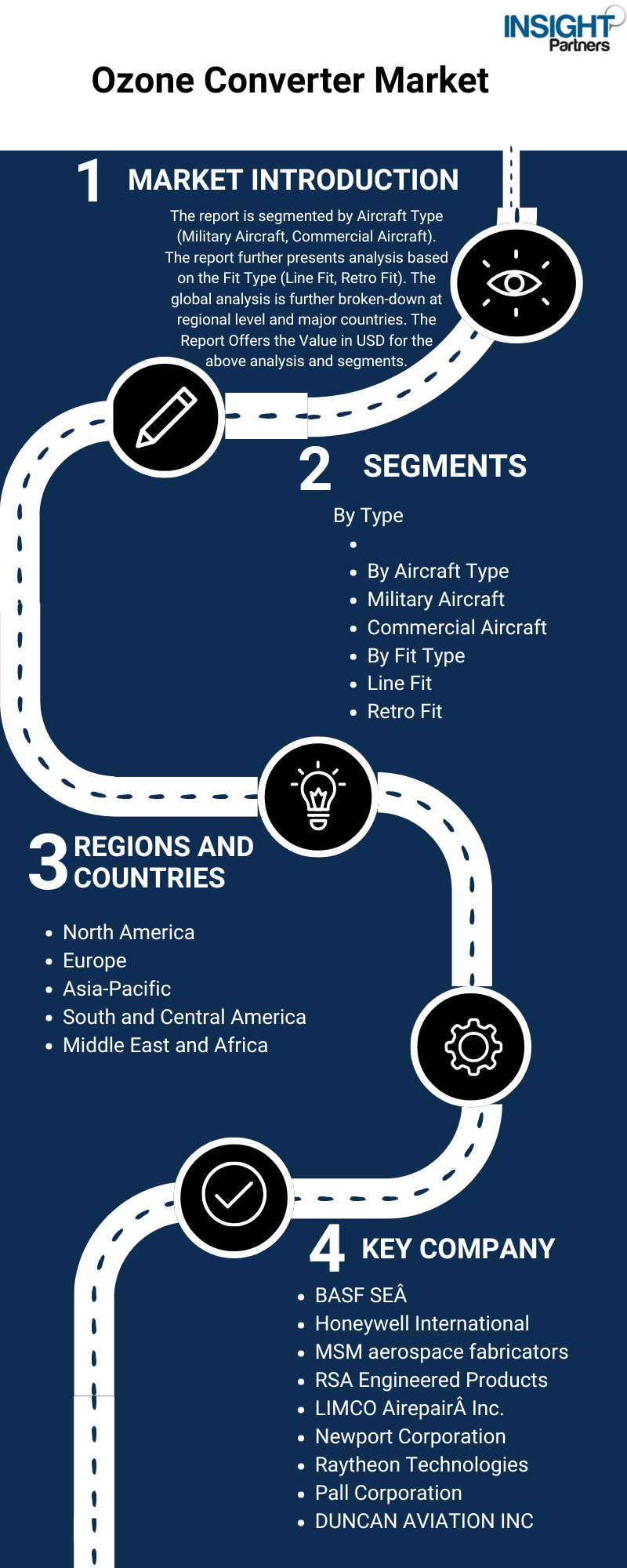The Insight Partners is delighted to present its latest market report, "Ozone Converter Market: An In-depth Analysis of Trends, Growth Drivers, and Forecast 2023–2031". The report offers a comprehensive picture of the Ozone Converter Market, examining the present state and forecasting future growth trends in this increasingly critical industry.
Overview of the Ozone Converter Market
The Ozone Converter Market is changing dynamically, fueled by a mix of environmental issues, technological advancement, and tighter emissions control across the aviation and industrial industries. Ozone converters, which play a key role in reducing harmful ozone emissions—especially in high-altitude aircraft cabin air systems and industrial exhaust flows—are picking up remarkable momentum as governments and businesses seek to minimize their carbon and ozone footprint.
Recent changes in demand, technological advancements, and regulation policies have brought about growth spurts as well as periods of stagnation in this niche market. This report gives insightful information on what's powering these trends and where the market is going.
Key Findings and Insights
Major Growth Drivers:
Strictness of environmental regulations by ICAO, FAA, and EASA increasing.
Growing demand for air travel that translates into greater commercial aircraft installations.
Industrial focus on emissions reduction and indoor air quality growing.
Advances in catalytic materials and light-weight converter designs.
Expansion of OEM partnerships and retrofit opportunities for legacy aircraft fleets.
Market Segmentation
The Ozone Converter Market is segmented in order to understand product differentiation and identify end-users better. The report presents the following segmentation in detail:
By Type:
Catalytic Ozone Converters
Non-Catalytic Ozone Converters
By Material:
Noble Metals (e.g., Platinum, Palladium)
Ceramic Substrates
Advanced Alloys and Coated Meshes
By Application:
Aircraft Cabin Air Systems
Industrial Air Treatment (e.g., chemical processing, semiconductor manufacturing)
Automotive Air Management (emerging)
By End-User:
Commercial Aviation
Military Aviation
Industrial Manufacturing Facilities
Environmental Monitoring & Control Systems
The segments are researched by current demand, projected growth rates, and regional trends for adoption, giving the stakeholders worthwhile information.
Identifying Emerging Trends
Technological Developments
The Ozone Converter Market is seeing the development of some revolutionary technologies:
Nano-catalytic coatings with more surface area and better conversion efficiency at lower temperatures.
3D printing (additive manufacturing) of converter housings to save weight and increase heat resistance for aerospace uses.
Ozone converters with integrated sensors that allow real-time monitoring of performance and predictive maintenance.
Hybrid systems combining ozone conversion with HEPA and VOC filters for greater air cleaning.
These technologies are not only enhancing performance but are also lowering long-term running costs as well as improving safety standards.
Shifting Consumer Preferences
Customer priorities in the ozone converter arena are changing at a very fast pace. Aerospace and clean manufacturing end-users, especially, now require:
Increased durability and longer product lifespan to minimize maintenance downtime.
Greener materials and lower lifecycle environmental footprint.
Integration with wider air management and filtration systems, tailored to their needs.
Intelligent systems that can interface with digital aircraft or industrial monitoring equipment.
This focus on sustainability and efficiency is affecting R&D and procurement strategies for OEMs and retrofit markets equally.
Regulatory Adjustments
Regulations remain a defining factor in the Ozone Converter Market:
ICAO's Annex 16 Volume II mandates a reduction in emissions of pollutants, including ozone, by aircraft manufacturers.
FAA regulations governing in-flight exposure to ozone have necessitated required installations of converters on long-haul flights.
EU's Clean Air Acts and Green Deal policies are expanding converter application to industrial plants.
Expected regulatory growth in APAC and Latin America could develop emerging demand hotspots.
Regulatory harmonization among leading markets is also motivating global companies to harmonize production and certification processes, which allows for quick entry into markets.
Growth Opportunities
1. Expansion of Aviation Industry
With airframe manufacture picking up after COVID and fleet upgrade schemes gaining momentum, particularly in developing economies, demand for ozone converters in new aircraft as well as retrofitting in the aftermarket will increase dramatically.
2. Expansion of Clean Manufacturing
Applications like pharmaceuticals, semiconductors, and chemicals demand very controlled air quality. Industrial ozone converters are becoming necessity to meet safety standards and avoid ozone-related damage to sensitive electronics and materials.
3. OEM Cooperation
There's growing cooperation between ozone converter manufacturers and aircraft system integrators (like those constructing ECS—Environmental Control Systems). Co-R&D can accelerate cycles of innovation and integration compatibility.
4. Material Innovation
New non-noble metal catalysts and lightweight composite housings can make converters much cheaper—enabling adoption in smaller planes and industrial uses that were cost-prohibitive before.
5. Asia-Pacific Market Penetration
Southeast Asia, India, and China are untapped markets, especially domestic aviation and fast-industrializing areas. Early expansion into these markets provides high ROI.
Conclusion
The Ozone Converter Market: Global Industry Trends, Share, Size, Growth, Opportunity, and Forecast 2023–2031 study provides a strategic framework for investors and existing players to invest or expand in this strategic environmental technology sector.
With demand fueled by environmental regulations, the aviation boom, and increasing industrial emissions control needs, ozone converters are becoming a must-have across industries. Innovation-driven, regulation-compliant, and cost-efficiently scalable companies will be in the best position to dominate this high-growth market.
About The Insight Partners
The Insight Partners is a leading provider of syndicated research, customized research, and consulting services. Our reports combine quantitative forecasting and trend analysis to offer forward-looking insights for decision-makers. With a client-first approach, we deliver actionable intelligence and strategic guidance across various industries.
For Reference - https://pin.it/e9fjBPeVh
Get Sample Report- https://www.theinsightpartners.com/sample/TIPRE00024424

